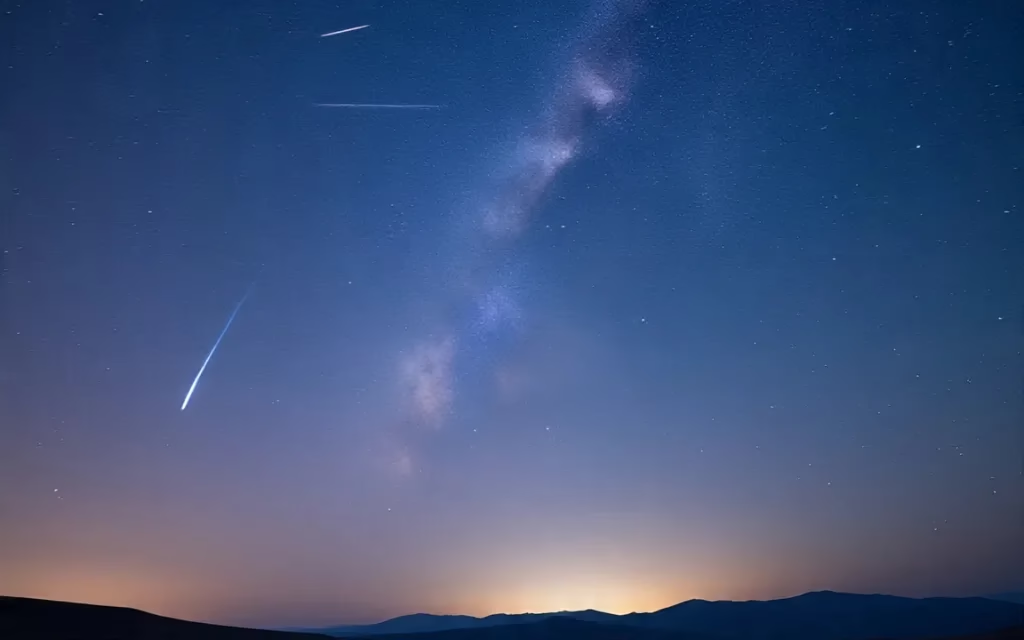Few astronomical events capture the imagination and awe of humanity like meteor showers. These breathtaking displays, often described as “shooting stars,” occur when tiny bits of cosmic debris burn up in Earth’s atmosphere, creating streaks of light across the night sky. For centuries, people across cultures have gazed upward in wonder, making wishes and marveling at the beauty of meteor showers.
In this article, we will explore what meteor showers are, how they occur, the best times to view them, and the science behind these stunning cosmic phenomena.
What Are Meteor Showers
Meteor showers happen when the Earth passes through a trail of debris left behind by a comet or, in some cases, an asteroid. These small particles, often no bigger than a grain of sand, enter Earth’s atmosphere at high speeds. The friction caused by this entry heats them up, producing bright trails of light we see as meteors.
While meteors can appear randomly at any time of the year, meteor showers are predictable events that happen at the same time each year. During a shower, dozens or even hundreds of meteors can be seen per hour, making them a favorite among stargazers and astronomy lovers.
The Science Behind Meteor Showers
The origin of meteor showers lies in the paths of comets orbiting the Sun. As a comet nears the Sun, its ice begins to vaporize, releasing dust and rock fragments into space. These materials spread out along the comet’s orbit. When Earth crosses this orbit, it encounters the debris, causing meteor showers to occur.
Each meteor shower is associated with a particular comet. For example, the Perseid meteor shower comes from the debris left by Comet Swift-Tuttle, while the Leonids are associated with Comet Tempel-Tuttle. These names help astronomers and enthusiasts track and prepare for upcoming meteor showers each year.
Famous Meteor Showers Around the World
There are several meteor showers that occur every year, each with unique characteristics. Here are some of the most famous and widely observed:
1. Perseids
The Perseid meteor shower, occurring every August, is among the most popular. It is known for its high meteor count, often peaking at 60 to 100 meteors per hour. The Perseids are best seen in the Northern Hemisphere and are famous for their bright and fast-moving meteors.
2. Geminids
Happening in December, the Geminid meteor shower is one of the most intense and reliable showers. It originates from an asteroid named 3200 Phaethon, making it unique among meteor showers, which usually come from comets.
3. Leonids
The Leonid meteor shower appears every November. It is known for producing spectacular meteor storms about every 33 years, where thousands of meteors can be seen each hour.
4. Quadrantids
Occurring in early January, the Quadrantid meteor shower is short but can be very intense. It peaks over a few hours and can produce up to 100 meteors per hour under perfect conditions.
5. Lyrids
The Lyrid meteor shower appears in April and is one of the oldest recorded showers, observed for over 2,700 years.
These meteor showers provide excellent opportunities for observing nature’s beauty and the wonders of space.
When and How to Watch Meteor Showers
Catching a meteor shower requires a bit of planning. To get the best view, consider these tips:
- Choose the right time: Most meteor showers are best viewed after midnight and before dawn when the sky is darkest.
- Find a dark location: Avoid city lights and light pollution. Rural areas or mountain tops offer the clearest skies.
- Check the moon phase: A full moon can outshine faint meteors. Try to watch when the moon is new or crescent.
- Give your eyes time to adjust: It takes 20 to 30 minutes for your eyes to fully adapt to the darkness. Avoid using your phone or other bright screens.
No special equipment is needed. Unlike telescopes, which narrow your field of view, the best way to enjoy meteor showers is with the naked eye.
The Cultural Significance of Meteor Showers
Throughout history, meteor showers have played a role in folklore, mythology, and even religious beliefs. In many cultures, a meteor was seen as a sign or omen. Ancient Greeks believed they were messages from the gods, while some Native American tribes saw them as the spirits of the dead.
Today, many people still make wishes when they see a shooting star. Though we now understand the science behind meteor showers, their magical and poetic qualities continue to inspire awe.
Meteor Showers and Astronomy Education
For students and educators, meteor showers provide an exciting way to introduce basic concepts in astronomy. Topics like Earth’s orbit, gravity, comets, and the structure of the solar system can all be explored using meteor showers as a teaching tool.
Planetariums, science museums, and astronomy clubs often organize public viewing events, making these celestial shows accessible and educational. Watching a meteor shower is one of the simplest yet most effective ways to spark curiosity about space and science.
How Meteor Showers Are Named
Meteor showers are usually named after the constellation from which the meteors appear to originate, a point called the radiant. For example, the Perseids radiate from the constellation Perseus, and the Leonids from Leo.
This naming system helps astronomers track and study meteor showers, and also assists in predicting when and where they will be visible in the night sky.
Meteor Storms: Rare but Extraordinary
While regular meteor showers may produce dozens of meteors per hour, there are rare events called meteor storms, where thousands of meteors can fall in a single night. These storms are unpredictable and short-lived but can create once-in-a-lifetime viewing experiences.
Historically, the 1833 Leonid meteor storm amazed viewers across North America, with some reports claiming more than 100,000 meteors per hour. Such displays fuel public interest and remain deeply etched in astronomical history.
Climate and Location Factors
Your geographical location affects your ability to see certain meteor showers. Some are best viewed from the Northern Hemisphere, while others may be more visible in the Southern Hemisphere. Weather also plays a crucial role. Cloud cover or rainy skies can completely block your view.
Using weather apps and astronomy calendars can help you plan the perfect night to view a meteor shower.
Safety and Environmental Considerations
Watching meteor showers is generally safe and peaceful. However, if you’re heading to remote locations for viewing, make sure to follow basic safety tips:
- Dress warmly if you’re in a cold region
- Bring blankets, chairs, or sleeping bags
- Inform someone about your location if you’re stargazing alone
Also, avoid disturbing local wildlife or leaving behind trash. Enjoying meteor showers should go hand in hand with respecting nature.
The Future of Meteor Shower Research
As technology improves, scientists are using new tools like radar, satellites, and AI to study meteor showers more accurately. These advancements help predict when the next big meteor storm might occur and even track the origins of the debris.
Studying meteor showers also helps in space exploration. Understanding how meteors interact with Earth’s atmosphere can improve spacecraft design and inform future space missions.
Conclusion
Meteor showers are one of the most beautiful natural events visible from Earth. They connect us to the cosmos, offering a reminder of our place in the vast universe. Whether you are an amateur stargazer, a professional astronomer, or just someone looking for a quiet moment of awe, meteor showers never fail to inspire.
Watching meteor showers is not only free and accessible but also a shared human experience across cultures and generations. So next time you hear of a meteor shower approaching, take a moment to look up. You may just catch a glimpse of the universe writing poetry across the sky.




